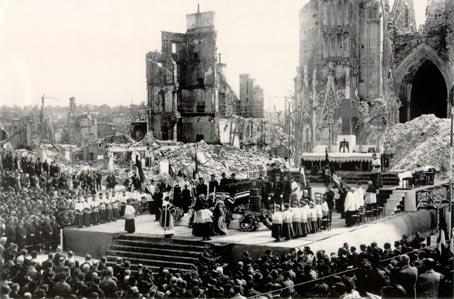| On July 16th, the 134th Infantry
Regiment, commanded by Col. (later Gen.) Butler
M. Miltonberger, and made up largely of Nebraska
National Guardsmen, was released from Corps Reserve
and entered the attack on the left of the 320th
and next to the 29th Division. Its men quickly
distinguished themselves capturing hill 122 which
overlooked St. Lo, taking the town of Emilic in
hand to hand fighting following close support
barrages as near as 75 yards, and with the help
of the 654th T.D. BN. and part of the 737th Tank
BN., joining with the division in throwing back
a major counterattack. The regiment received a
Distinguished Unit Award and the 3rd Battalion
received the French Croix de Guerre for their
part in this operation.
Air Force P-47s provided excellent help with
strafing and bombing, and on July 19th the division
was on the North edge of St. Lo, held there while
a combat team of the 29th Division was given the
green light to move into the city from the East
and clean out the last German stragglers and a
few gun positions. St. Lo had been taken.
While the media gave credit to the 29th Division for taking St.
Lo, all who were there know that it required the maximum input of
all the four divisions involved. A letter of commendation to Gen.
Baade from Gen. Coslett acknowledged the successful conclusion of
the initial combat action of the 35th Infantry Division and the
repeated personal and group heroism attendant thereto. When Senator
Harry E. Truman, a former Captain in the 129th Field Artillery of
the 35th Division in World War I, received a copy of the letter,
he was so pleased with his old outfit that he had the letter inserted
verbatim into the Congressional Record.

Liberation of Saint Lo, 1944, Photo "La
Manche Libre" - Robert Pouchin
In later years, Lt. Col. John Hoyne, Division
G-2 commented frequently that if there was one
failure in the division it lay in the non-recognition
of innumerable acts of heroism that occurred in
the division, and the failure to write up actions
and recommend Santa Fe soldiers for medals. so
many worthy actions were later forgotten or the
witnesses themselves had become casualties. No
one had been assigned the duty of securing proper
recognition to its soldiers. Col. Hoyne felt that
there should have been many more Bronze and Silver
Stars and Distinguished Service Crosses awarded
within the division. We agree, and that was particularly
true in the battle for St. Lo.
The capture of St. Lo did lay the foundation
for the breakout from the Normandy bridgehead,
which became the next combat action for the division.
It was code named “Cobra” and it was
to begin on July 25th, 1944. The battle of Normandy
was over.
 Learn
more in Northern France Learn
more in Northern France
 Or
go back to where you started, in Normandy Or
go back to where you started, in Normandy
|